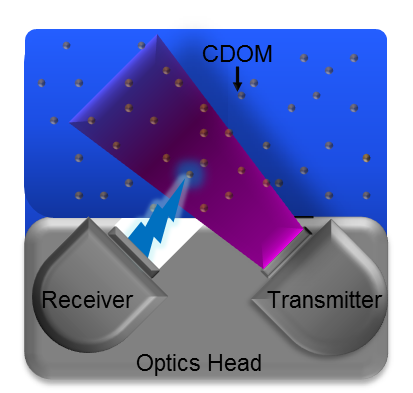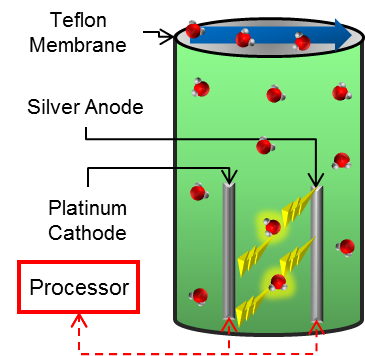Click here for details
RECON Sensor Package Details


Each River, Estuary and Coastal Observing Network (or RECON) sensor package is composed of several components that work together to form an integrated sensor suite known as Land/Ocean Biogeochemical Observatory (LOBO).
The LOBO is attached to a piling or dock using a custom designed support structure. The support structure is permanently attached to the piling. The LOBO can then be disconnected from the support structure for servicing. This insures that it is always redeployed at the exact same position in the water column.


1. A WET Labs ECO FLS fluorometer measures Colored Dissolved Organic Matter (CDOM). This sensor works by projecting a beam of light at a specific wavelength (370 nm) into the water column. The photons cause CDOM in the water to fluoresce (emit light at a longer wavelength). The process of fluorescence is described elsewhere. The sensor measures the amount of emitted light (in this case at a wavelength of 460 nm, blue light) from which the concentration of CDOM is calculated.

2. Chlorophyll a, Turbidity, Conductivity (Salinity), Temperature, Dissolved Oxygen, Pressure (Depth) are measured by the WET Labs Water Quality Monitor (WQM).


Chlorophyll a is also measured with a fluorometer in the same manner as CDOM, but using a 470 nm wavelength of light and measuring the amount of emitted light a wavelength of 695 nm ( red light). Chlorophyll a is measured in ug/l.

Turbidity is measured using a nephelometer. A nepelometer measures turbidity by measuring the amount of light scattered, by particles in the water, at an angle of 90° from the incident beam. Turbidity is measured in Nephelometric turbidity units (NTU).

Conductivity is measured using a conductivity cell. Water is pumped through the conductivity cell, located in the WQM's Conductivity, Temperature, Dissolved Oxygen (CT-DO) chamber. A small electrical current is passed through the water between two electrodes connected to a computer processor. The electrical resistance of the water is measured and used to calculate conductivity which is then used to calculate salinity. Conductivity is measured in Siemens per meter (S/m).

Temperature is measured using a thermistor and is outputted in degrees centigrade. A thermistor is a resistor with resistance that varies according to temperature. It is housed in a stainless steel probe. The probe is located at the inlet of the CT-DO chamber. The thermistor is connected to a computer processor that calculates the temperature of the water.

Dissolved Oxygen (DO) is measured using a modified Clark electrode. A platinum cathode and silver anode are sounded by a potassium chloride solution, held in by a Teflon membrane that only transmits oxygen, and not larger ions present in seawater. Water passes over the outside of the Teflon membrane. The membrane is permeable to oxygen, allowing oxygen atoms to diffuse across it into the potassium chloride solution. A constant voltage difference is held across the two electrodes causing electrons to leave the platinum electrode and combine with oxygen atoms diffusing across the membrane from the surrounding water. The rate in which the electrons leave the electrode is proportional to the concentration of dissolved oxygen in the water. The movement of electrons is an electrical current, which can be measured and used in an equation along with temperature, salinity, and pressure to calculate dissolved oxygen concentration. DO is measured in mg/l.

Pressure is measured with a pressure transducer to calculate Depth. The pressure sensor is located inside a chamber filled with silicone oil. The oil transfers the pressure of the surrounding water to the sensor and is proportional to the amount of force the water column exerts on it. The force measured is then used to calculate depth. Depth is reported in meters.
3. Nitrate is measured by Satlantic's ISUS V3 sensor. The sensor works by passing a beam of ultra-violet light (200-400 nm) through the water column. The beam is reflected off of a mirror and read by a spectrometer. The spectrometer measures the amount of light that is absorbed by the water for each wavelength. An algorithm is then used to calculate the nitrate concentration in the water in micro moles (for more detail, see Johnson and Coletti 2003.)



4. A Satlantic 51 Ah Battery Pack powers the sensors. Standard D-cell batteries are connected in series to produce the 15-volt out of the battery pack. Locations with weather stations are equipped with solar power systems. We are working on converting all sites to solar.

5. A Satlantic STOR-X Data Logger controls all of the input and data gathering from the various sensors. It regulates their sampling and compiles their data into a single file. It then sends this file to the server via a GSM cell phone modem.
6. A marine grade aluminum mounting cage houses all the sensor components.

7. & 8. A GSM modem transmits the data to the server.
Not pictured: Current (flow) is measured by a Nortek Aquadopp current profiler which both speed and direction that the water is flowing using the Doppler Effect. The Doppler Effect is a change in the observed frequency of a wave of sound, occurring when the source and observer are in motion relative to each other. The Aquadopp uses two sound beams projected into the water column. The sound reflects off of particles in the water. The sensor measures the change in frequency of the sound that is reflected back. Using its internal compass and tilt sensors it is then able to calculate current speed and direction.

